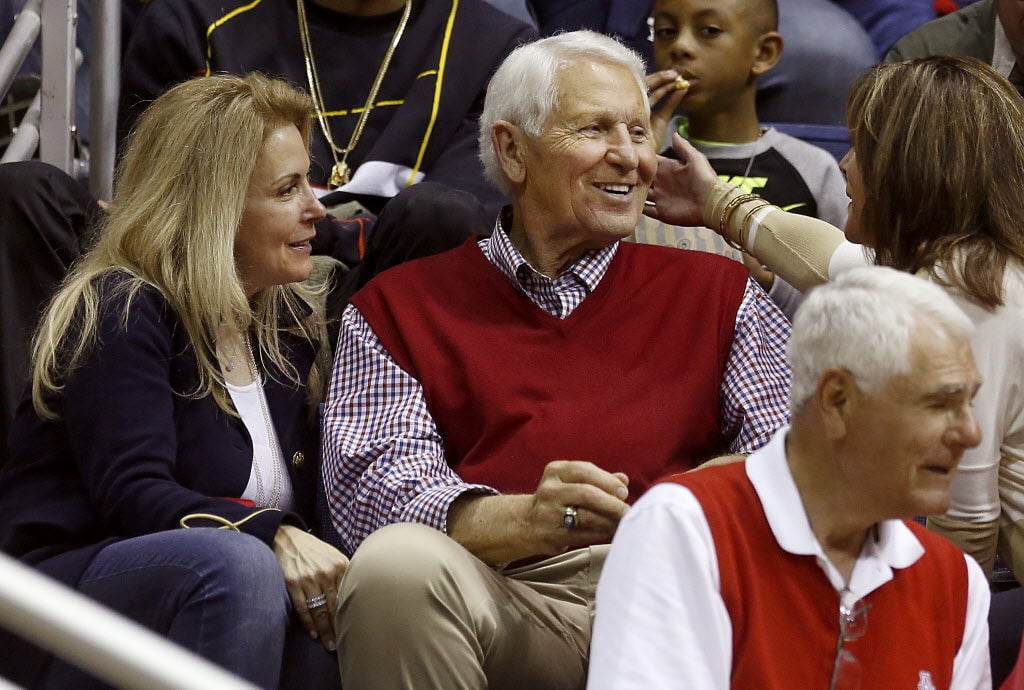Lute Olson was sitting at Gate A3, awaiting a Southwest flight to Los Angeles for Arizona’s recent UCLA-USC swing. He looked different than I’ve ever seen him.
He was wearing glasses.
It took me back to the 2005 Elite Eight in Chicago, Arizona vs. No. 1 Illinois. Someone in the media audience asked Olson if he planned to retire soon.
“I don’t take any medications,” he said. “I don’t even need reading glasses.”
Olson was 70. Nobody was going to take him down.
From the day Olson walked into Tucson, in April 1983, he appeared to be indestructible. A friend from Oregon was visiting one day in the spring of 1994, a month after Arizona played in its second Final Four, and asked if I would show him around McKale Center.
We were in a corridor near the old weight room when Olson, in workout gear, walked by.
“Holy cow,” my friend said. “Lute looks like he could play tight end in the NFL right now.”
Olson was 59.
Today, at 81, he wears reading glasses. He told me a week ago he had tweaked his back, which has cut back his golf schedule.
Indestructible? Time touches all of us, even coaching legends.
After Arizona beat Washington two weeks ago, Olson and his wife, Kelly, went to the Huskies locker room to say hello to UW coach Lorenzo Romar. The two embraced and chatted, forgetting those heated battles in Seattle, especially that remarkable double-overtime New Year’s Eve game of 2005, when Olson beat Romar’s No. 7 Huskies 96-95.
As Olson walked away, Romar looked at me and said “do you realize what that guy built here?”
Talk about preaching to the choir.
Olson coached his last game at McKale Center on Feb. 17, 2007. The school had already put his signature on the court, naming the floor after him for posterity. A few years later it painted a hallway outside Sean Miller’s office with a vibrant, life-size image of Olson.
Is that enough? Should not the entry to McKale include a statue of the man who transformed not only the image of the UA athletic department, but that of Tucson?
Until Olson arrived from Iowa, Tucson’s image to outsiders was that John Wayne used to make a lot of good movies here. It was Tumbleweed Junction. But that all changed once Olson took command of the Pac-12 and built one of the most successful college sports programs in the West.
Without Olson, there would be no Greg Byrne at Arizona. No Sean Miller.
Shouldn’t the school erect a statue of Olson before he’s 91 or 101, while he’s still here to see and appreciate it?
After Arizona’s dramatic loss last week at Cal, I walked from the Haas Pavilion media room to a pavilion where several hundred Bears fans gather for pregame drinks and appetizers.
A statue of Pete Newell stands at the entry.
Newell coached Cal to the 1959 NCAA championship. The Bears didn’t think to erect a statue of him until 2006, when he was 91.
Two weeks earlier, on Arizona’s trip to USC and UCLA, I walked on the campuses of both schools. I stood in front of the John McKay statue at USC’s $70 million John McKay Center. Both were built 11 years after McKay’s death.
He won four national championships at USC, making it an enduring national power. The school waited almost 40 years to honor him properly. They waited until he was dead.
At UCLA, the John Wooden statue sits outside refurbished Pauley Pavilion. Wooden died in 2010; he was 99. UCLA then began work on the 8-foot high bronze statue.
Other schools have acted with better timing.
UNLV erected a statue to Jerry Tarkanian before he died. Arizona State has a statue of Frank Kush, who did to that school’s national reputation and local image in football as Olson did to Arizona and Tucson.
Ole Miss built a statue of former football coach John Vaught; Florida State honored football coach Bobby Bowden with a statue. There are many others: Vince Dooley at Georgia; Tom Osborne at Nebraska; Ara Parseghian at Notre Dame; Don Faurot at Missouri; Frank Broyles at Arkansas; even still-active Nick Saban at Alabama.
Basketball? North Carolina State is in the planning stages of a statue of Jim Valvano. Michigan State will similarly construct a statue of Jud Heathcote. UTEP is in the process of building a memorial for Don Haskins.
One of my enduring memories of Tucson is attending the dedication of the John “Button” Salmon bust outside McKale Center. It was 1986, almost 60 years since the death of Arizona’s “Bear Down” legend.
I was introduced to Clyde “Babe” Lockie, Button’s sister. She was in tears.
“It’s long overdue,” she said. “But I know, wherever he is, Johnny will be pleased.”
Maybe this time we can avoid the tears.





